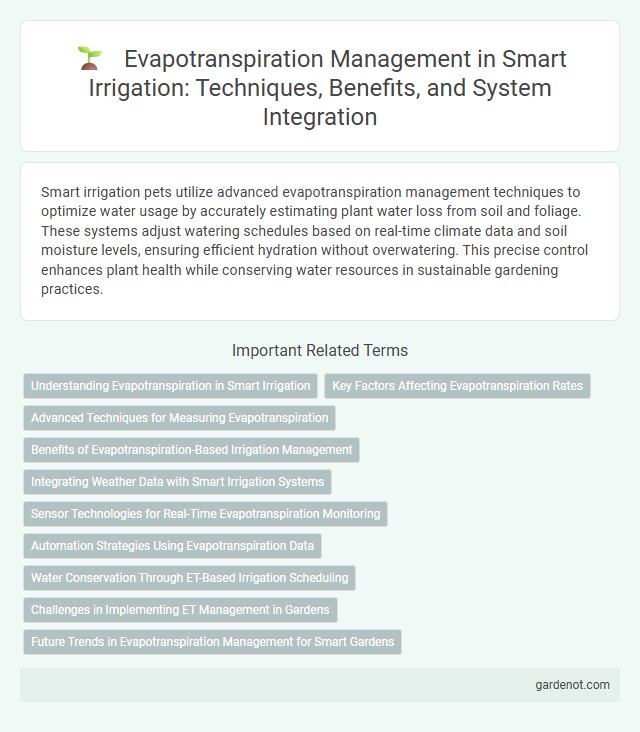Smart irrigation pets utilize advanced evapotranspiration management techniques to optimize water usage by accurately estimating plant water loss from soil and foliage. These systems adjust watering schedules based on real-time climate data and soil moisture levels, ensuring efficient hydration without overwatering. This precise control enhances plant health while conserving water resources in sustainable gardening practices.
Understanding Evapotranspiration in Smart Irrigation
Evapotranspiration (ET) represents the sum of water evaporation from soil and transpiration by plants, directly influencing irrigation scheduling in smart irrigation systems. Accurate measurement and modeling of ET enable precise water application, reducing waste and promoting plant health. Integrating real-time weather data and soil moisture sensors refines ET estimates, optimizing irrigation efficiency and sustainability.
Key Factors Affecting Evapotranspiration Rates
Evapotranspiration rates in smart irrigation are primarily influenced by temperature, humidity, wind speed, and solar radiation, which dictate water loss from soil and plants. Soil moisture levels and crop type significantly affect evapotranspiration, guiding precise water application to optimize efficiency. Accurate monitoring of these factors through sensors and weather data ensures sustainable water use and improved crop health.
Advanced Techniques for Measuring Evapotranspiration
Advanced techniques for measuring evapotranspiration in smart irrigation include the use of remote sensing technologies such as satellite imagery and aerial drones equipped with multispectral sensors to analyze crop water use accurately. Eddy covariance systems provide direct measurements of water vapor fluxes between the land surface and atmosphere, offering precise data for optimizing irrigation schedules. Integrating soil moisture sensors with weather stations enhances real-time monitoring and predictive modeling, improving water use efficiency and crop yield.
Benefits of Evapotranspiration-Based Irrigation Management
Evapotranspiration-based irrigation management enhances water use efficiency by precisely aligning irrigation schedules with actual crop water needs, significantly reducing water waste. This method supports healthier plant growth and maximizes crop yield by preventing overwatering and underwatering. Incorporating evapotranspiration data into smart irrigation systems leads to sustainable water conservation and optimized agricultural productivity.
Integrating Weather Data with Smart Irrigation Systems
Integrating precise weather data such as temperature, humidity, solar radiation, and wind speed into smart irrigation systems enhances evapotranspiration management by delivering more accurate water application tailored to actual crop water needs. Advanced sensors and IoT devices collect real-time environmental data, enabling irrigation controllers to adjust watering schedules dynamically, reducing water waste and promoting sustainable agriculture. Leveraging weather forecasts along with historical climate data optimizes irrigation efficiency, leading to improved crop yield and resource conservation.
Sensor Technologies for Real-Time Evapotranspiration Monitoring
Sensor technologies for real-time evapotranspiration monitoring enhance smart irrigation by providing precise data on water loss through soil and plant surfaces, enabling optimized water usage. Devices like soil moisture sensors, weather stations, and leaf wetness sensors collect continuous environmental inputs that feed advanced algorithms to calculate evapotranspiration rates accurately. Integrating these sensors into irrigation systems reduces water waste, improves crop yield, and supports sustainable agricultural practices.
Automation Strategies Using Evapotranspiration Data
Automation strategies in smart irrigation leverage evapotranspiration (ET) data to precisely regulate water application, optimizing crop hydration while minimizing waste. Integrating real-time ET measurements with soil moisture sensors and weather forecasts enables adaptive irrigation schedules that respond to changing environmental conditions. This approach enhances water use efficiency, reduces operational costs, and supports sustainable agricultural practices by aligning irrigation with actual plant water demand.
Water Conservation Through ET-Based Irrigation Scheduling
Evapotranspiration (ET)-based irrigation scheduling optimizes water use by matching irrigation precisely to crop water requirements, reducing waste and enhancing conservation. By leveraging real-time ET data from weather stations and soil sensors, this method adjusts watering frequency and volume to current environmental conditions, promoting efficient resource management. Implementing ET models in smart irrigation systems results in significant water savings while maintaining crop health and productivity.
Challenges in Implementing ET Management in Gardens
Evapotranspiration management in smart irrigation faces challenges such as accurately measuring ET rates due to microclimate variability and heterogeneous soil conditions within garden environments. Limited access to precise weather data and the complexity of integrating real-time ET sensors with irrigation systems hinder optimal water application. Additionally, the high costs of advanced ET monitoring technologies and the need for user-friendly interfaces restrict widespread adoption in residential garden settings.
Future Trends in Evapotranspiration Management for Smart Gardens
Future trends in evapotranspiration management for smart gardens emphasize integrating AI-driven sensors with microclimate data to precisely monitor water usage and plant needs. Advanced machine learning algorithms predict evapotranspiration rates based on weather forecasts, soil moisture, and plant types, optimizing irrigation schedules for water conservation. Innovations in IoT connectivity enable real-time adjustments to irrigation systems, enhancing sustainability and improving plant health in residential and commercial smart gardens.
Evapotranspiration management Infographic

 gardenot.com
gardenot.com